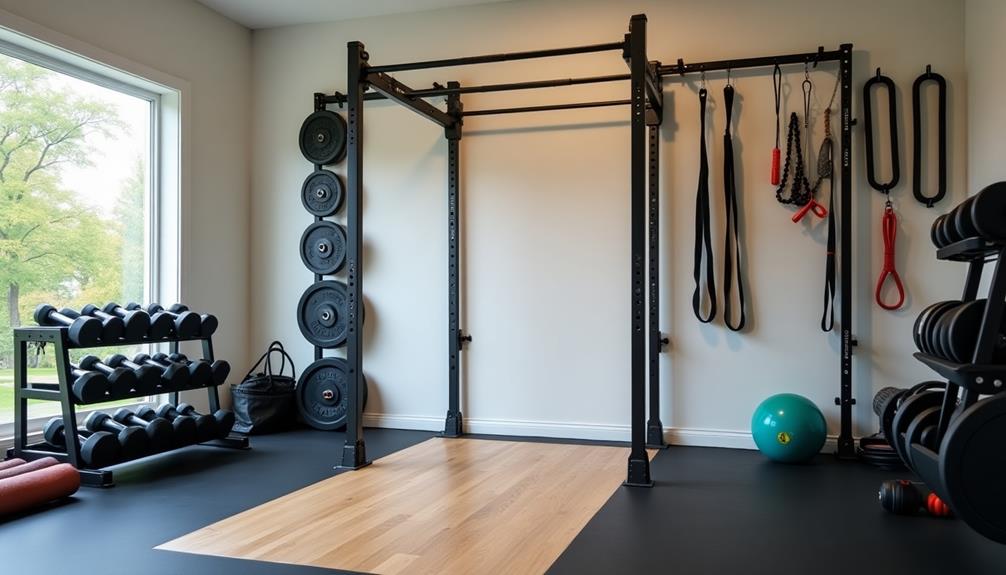Mastering resistance training is key for boosting your strength and overall fitness. Start by understanding the basic movements like squats and deadlifts, which engage major muscle groups. Incorporate various types of exercises, including bodyweight and free weights, to keep your routine fresh. Essential equipment like dumbbells and resistance bands can enhance your workouts. Remember to focus on proper form to maximize gains and prevent injury. Fuel your body with adequate protein and carbs to support muscle repair and energy. Tracking your progress is important, as it helps you adjust your program and avoid plateaus. There's more to explore, so let's keep going.
Core Insights
- Focus on major movements like squats, deadlifts, and bench presses to engage multiple muscle groups effectively.
- Maintain proper form and technique to maximize strength gains and prevent injuries during workouts.
- Incorporate a variety of resistance exercises using free weights, bands, and machines for balanced strength development.
- Track your progress consistently to evaluate performance and make necessary adjustments to your training program.
- Ensure adequate nutrition, with sufficient protein and carbs, to support muscle repair and energy during resistance training.
Understanding Resistance Training

Resistance training is a powerful tool for building strength and enhancing overall fitness. It involves using external resistance, like weights or resistance bands, to challenge your muscles. This type of training isn't just for bodybuilders; it's beneficial for everyone, regardless of fitness level.
To get started, you'll want to focus on key movements. These include squats, deadlifts, and bench presses. Each exercise targets major muscle groups, helping you develop balanced strength.
It's essential to maintain proper form to prevent injuries, so consider seeking guidance from a trainer if you're unsure. Start with lighter weights and gradually increase the resistance as you grow stronger.
Understanding the fundamentals of resistance training sets the foundation for effective workouts and long-term progress.
Benefits of Strength Training

Strength training consistently offers a wide range of benefits that go beyond just building muscle. First, it enhances your overall strength, making daily tasks easier. You'll notice improvements in your physical performance, whether you're lifting groceries or climbing stairs. Additionally, strength training boosts your metabolism, helping you burn more calories even at rest. For those working out at home, Smith machines provide a versatile and safe option for resistance training, allowing you to target multiple muscle groups effectively. It also promotes bone health, reducing the risk of osteoporosis as you age. Mental benefits are significant, too; regular training can enhance your mood and reduce anxiety. You'll feel more confident and capable as you progress. Ultimately, strength training can help improve your posture and balance, reducing the risk of injury. Overall, incorporating strength training into your routine is a smart move for both body and mind.
Types of Resistance Exercises

When it comes to building muscle and improving fitness, various types of resistance exercises can help you achieve your goals. These exercises can be categorized into a few main types.
1. Bodyweight Exercises: These use your body weight as resistance. Think push-ups, squats, and lunges.
2. Free Weights: Dumbbells and barbells offer versatility and challenge your muscles differently as you lift them.
3. Resistance Bands: These portable tools provide adjustable resistance and are great for both strength and rehabilitation. When selecting resistance bands, consider different resistance levels to match your fitness goals and exercise types. Look for durable natural latex bands for longevity and best performance.
4. Machine Weights: Gym machines guide your movement, making it easier to focus on specific muscle groups.
Incorporating a mix of these exercises into your routine will enhance strength, build muscle, and keep your workouts engaging.
Essential Equipment for Training

To maximize your training effectiveness, having the right equipment is essential. Start with a quality set of dumbbells. They're versatile and perfect for a range of exercises. Adjustable dumbbells save space and allow for varying weights. Next, consider resistance bands. They're portable and great for adding intensity to your workouts. A stability ball can enhance core strength and balance. For functional training, medicine balls are excellent tools to improve power and explosiveness. They come in various weights and sizes to suit different fitness levels. If you're working out at home, a squat rack or bench can be beneficial for safety and support. Lastly, don't overlook a quality mat for floor exercises. It provides comfort and stability. With this essential equipment, you'll be well-prepared to engage in effective resistance training, ensuring you get the most out of your workouts.
Designing a Training Program

- Define Your Goals: Are you aiming for strength, endurance, or muscle size? Your objectives will shape your program.
- Choose Your Exercises: Incorporate a mix of compound and isolation exercises to engage various muscle groups.
- Set a Schedule: Create a weekly routine that allows for adequate recovery while maintaining consistency.
When you design your program, keep it flexible. Adjust as you progress or if your goals change. This approach not only keeps your workouts engaging but also helps you achieve better results over time.
Proper Form and Technique

Maintaining proper form and technique during resistance training is essential for maximizing strength gains while minimizing the risk of injury. Start with your stance. Keep your feet shoulder-width apart for stability. When lifting, engage your core to protect your back. Always focus on controlled movements, avoiding rapid jerks that can lead to strain.
Next, pay attention to your joint alignment. Make sure your knees don't extend beyond your toes during squats or lunges. This keeps your joints safe and enhances muscle engagement. Finally, don't hesitate to use a mirror or ask for feedback. Observing your form can reveal areas needing improvement. Consistently practicing these guidelines will help you build strength effectively while ensuring your safety throughout your training journey.
Nutrition for Strength Gains

When it comes to building strength, nutrition plays a pivotal role in your training regimen. To maximize your strength gains, focus on these key components:
- Protein Intake: Make sure you're consuming enough protein to support muscle repair and growth. Aim for about 1.6 to 2.2 grams of protein per kilogram of body weight daily.
- Carbohydrate Sources: Carbs are your body's primary energy source. Incorporate whole grains, fruits, and vegetables to fuel your workouts and replenish glycogen stores.
- Healthy Fats: Don't shy away from fats. Include sources like avocados, nuts, and olive oil to support hormone production and overall health.
Tracking Progress and Adjustments

Tracking your progress is crucial for optimizing your strength training routine. You need to monitor your workouts consistently. Start by recording the weights you lift, the number of sets and reps, and any other pertinent details. This data helps you identify patterns and improvements over time.
Next, evaluate your progress regularly—weekly or biweekly works well. Adjust your training based on these evaluations. If you're plateauing, consider increasing the weight or changing your rep scheme. It's also important to listen to your body; if you're feeling fatigued, incorporate deload weeks or active recovery days.
Frequently Asked Questions
How Can I Prevent Injuries While Resistance Training?
Preventing injuries while resistance training's like building a sturdy house; you need a solid foundation. Focus on proper form, warm up thoroughly, listen to your body, and gradually increase weights to stay safe and strong.
What Should I Wear During Resistance Training Sessions?
When you're resistance training, wear comfortable, breathable clothing that allows for movement. Opt for supportive footwear to protect your feet and enhance stability. Avoid loose clothing that might get caught during your exercises. Stay safe and focused!
Can Beginners Practice Resistance Training at Home?
Absolutely, you can practice resistance training at home! Just like superheroes train in their secret lairs, you can use bodyweight exercises or resistance bands to build strength effectively right in your living room. Start small and progress!
How Long Does It Take to See Strength Improvements?
You'll typically notice strength improvements within 4 to 6 weeks of consistent training. Your body adapts to the stress, so keep challenging yourself, and you'll see progress as you stay committed to your routine.
Is It Safe to Train While Pregnant or Postpartum?
Like a warrior preparing for battle, you can safely train during pregnancy or postpartum with the right precautions. Consult your healthcare provider, listen to your body, and focus on gentle movements to maintain strength and wellness.

